Ancient civilizations primarily used four types of vessels for lye blending: clay pots with wide mouths for their chemical resistance, stone basins carved from rock for durability, bottomless wooden barrels for efficient leaching, and later, metal kettles for advanced production. Your choice of container depended on local resources—pottery in clay-rich regions, wood in forested areas. Each vessel type represents fascinating developments in early soap-making technology that transformed human hygiene throughout history.
Materials and Properties of Ancient Lye Vessels

While modern soap-making utilizes industrial equipment, ancient civilizations developed specialized vessels that could withstand the harsh properties of lye. Clay and stone containers were primarily used, as they resisted the caustic nature of lye solutions derived from wood ashes.
You'd find these ancient vessels featured wide mouths for easy pouring and sturdy bases to support the weight of the mixture. Notably, some cultures deliberately chose porous materials to enhance filtration during the lye extraction process.
To combine the advantages of different materials, wooden containers lined with clay were sometimes employed, preventing direct contact between wood and corrosive lye.
Archaeological evidence reveals thoughtful design elements like drainage channels that directed liquid lye into collection vessels, making the soap-making process more efficient in these early production methods.
Clay Pots and Ceramic Containers in Early Soap Production
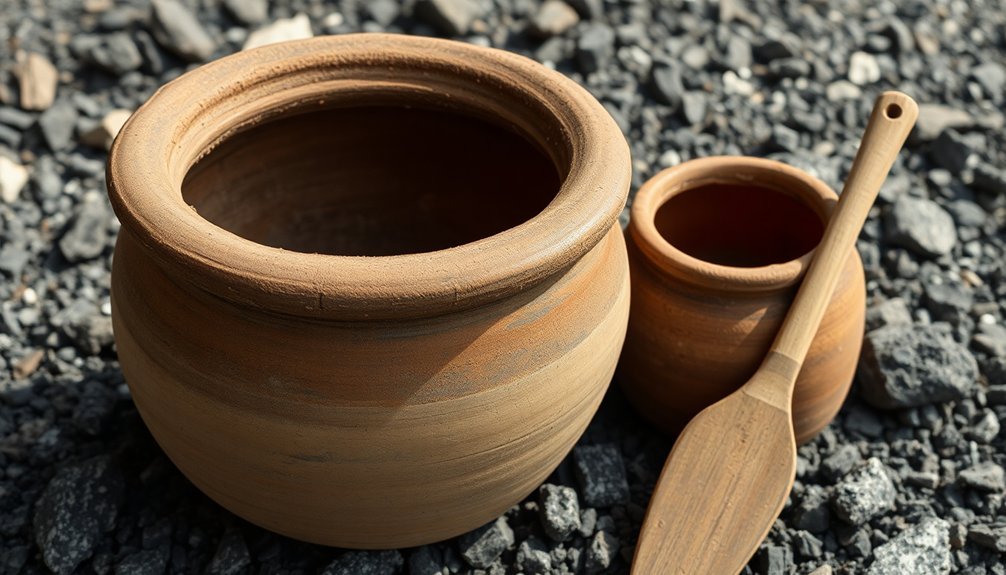
Among the diverse materials used for lye processing, clay pots and ceramic containers stand out as the workhorses of early soap production.
You'll find these vessels were especially valued for their heat resistance during the intense lye blending process, allowing artisans to safely combine caustic ingredients without vessel deterioration.
Crafted from local clay resources, these containers offered a practical solution for soap makers.
Their porous structure provided an added benefit during lye extraction—when used for leaching wood ashes, the ceramic naturally facilitated the process.
Unlike metal alternatives, clay pots remained chemically inert when exposed to caustic lye, preserving both the vessel and soap quality.
Archaeological discoveries of these ceramic containers at ancient soap-making sites confirm their essential role in early production methods.
Stone Basins and Lye Leaching Systems
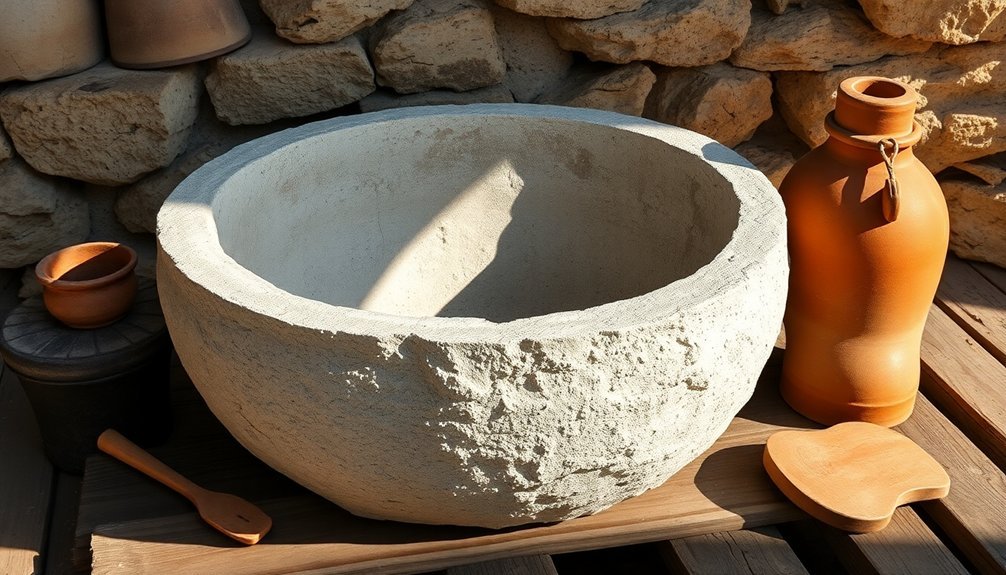
Craftsmen of ancient soap-making civilizations relied heavily on stone basins as their primary vessels for lye processing.
You'll find these durable containers were strategically positioned at slight angles, allowing the caustic mixture to flow efficiently during the production of soap.
Stone basins proved ideal for combining wood ash with water to create potash, withstanding the corrosive nature of lye that would damage other materials.
Sophisticated lye leaching systems featured flat stones with precisely carved channels and grooves that facilitated drainage as the brownish liquid seeped through ash layers.
This ingenious design reflects how early soap makers mastered natural resource utilization.
The stone vessels' durability guaranteed consistent soap production across generations, demonstrating remarkable engineering prowess in cultures that lacked modern manufacturing capabilities.
Wooden Barrels and Ash Hoppers for Potash Extraction
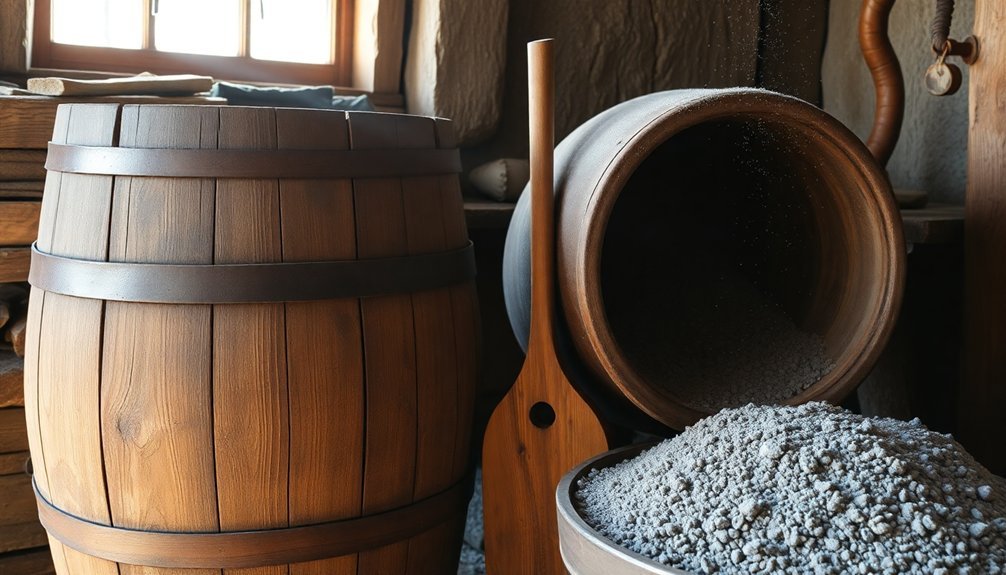
Pioneers of ancient soap making soon discovered wooden barrels offered practical alternatives to stone basins for lye production.
They'd typically remove the barrel's bottom, creating a vessel that contained wood ashes while allowing the essential potash to leach out during lye extraction.
Ash hoppers emerged as specialized alternatives, featuring more open structures that enhanced water flow through the ashes.
You'd begin by placing straw or twigs at the bottom of these vessels to prevent clogging and improve filtration.
Hot rainwater was the preferred liquid, as it efficiently dissolved the potash compounds within the ashes.
Once water percolated through, you'd collect the resulting brownish lye solution from the bottom of your barrel or hopper, ready to begin the soap-making process.
Metal Kettles and Cauldrons in Historical Soap Making
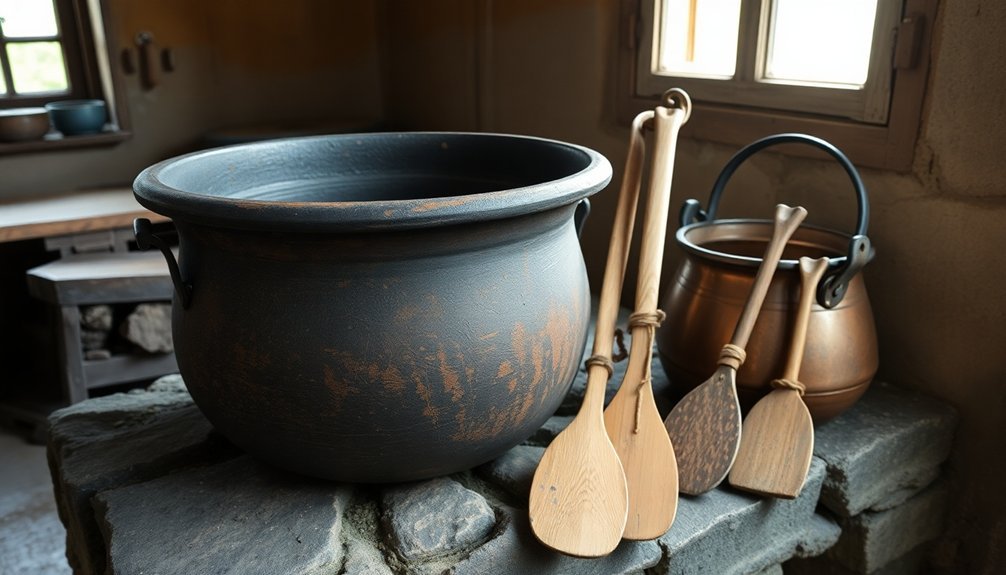
When making soap historically, you'd need to choose between copper kettles, prized for even heat distribution, or iron cauldrons that offered durability but potentially darkened the soap.
You'll find that properly handling the corrosive lye solution required special techniques and tools to prevent dangerous splashing and avoid damage to both the vessel and yourself.
The kettles varied dramatically in size, from small household pots producing a few pounds of soap to massive commercial cauldrons capable of yielding hundreds of pounds in a single batch.
Copper vs. Iron Kettles
Although both materials served essential roles in historical soap making, copper and iron kettles offered distinct advantages that influenced their selection for lye blending. You'd find copper kettles prized for their superior heat conductivity, ensuring your soap mixture boiled evenly during saponification without burning the fats.
Iron cauldrons, while heavier, provided exceptional durability and rust resistance. Savvy soap makers often lined these vessels with fat to prevent chemical reactions between the lye and metal.
| Feature | Copper Kettles | Iron Cauldrons |
|---|---|---|
| Heat Conductivity | Excellent | Good |
| Reactivity | May react with lye | Minimal when lined |
| Maintenance | Regular polishing | Fat lining needed |
Both vessel types were sized generously, accommodating the large batches typical of communal soap making practices that characterized early production methods.
Handling Corrosive Lye
Since lye's caustic nature could quickly destroy inadequate containers, soap makers developed specialized techniques for handling this dangerous substance in their metal vessels. You'd find that copper and cast iron metal kettles were preferred for their exceptional resistance to lye's corrosive properties during the soap-making process.
Before blending lye, you'd need to meticulously clean your kettle to prevent contamination that could ruin an entire batch. The size of your vessel would depend on your production needs—household soap makers typically used smaller pots, while commercial operations required substantial cauldrons.
Though wooden and stone vessels occasionally served as alternatives, they'd deteriorate much faster than metal. Experienced soap makers understood that investing in quality metal kettles ultimately guaranteed safer handling and more consistent results when working with this hazardous but essential ingredient.
Size and Capacity Variations
Three distinct sizes of metal kettles emerged throughout the history of soap making, each serving specific production needs.
Small kettles, typically holding 1-2 gallons, were perfect for household soap production where limited quantities were required.
Medium-sized vessels, accommodating 3-5 gallons, suited small businesses or community soap making endeavors.
The largest cauldrons, capable of holding 6+ gallons, became essential for commercial operations where efficiency demanded larger batches.
These substantial vessels withstood the rigorous 6-8 hour boiling periods without warping, their metal construction ensuring even heat distribution throughout the soap making process.
You'd find these kettles designed with wide openings and sturdy handles to facilitate the constant stirring required to achieve proper consistency in your soap mixture.
Regional Variations in Lye Blending Equipment
Throughout the Mediterranean basin, you'll find stark contrasts between ceramic and wooden vessels used for lye blending.
While Romans preferred durable ceramic amphorae that withstood harsh chemical reactions, Greeks opted for wooden barrels and troughs that were readily available in their forested regions.
These regional preferences weren't merely aesthetic choices but practical adaptations to local resources and specific soap-making techniques developed over centuries.
Ceramic vs. Wooden Vessels
Ancient societies developed distinct preferences for lye blending equipment, with ceramic and wooden vessels representing the primary regional variations.
You'll find that Romans and Egyptians favored ceramic vessels for their chemical resistance to alkaline substances and impressive durability during the lye blending process. These containers featured characteristically thick walls to manage the heat generated during chemical reactions.
In contrast, rural and nomadic communities often utilized wooden vessels, which were more accessible and easier to construct. Your choice of container would have largely depended on local resource availability—pottery dominated in regions with established clay sources, while wooden containers prevailed in forested areas.
Though practical, wooden vessels required meticulous maintenance to prevent leakage, highlighting the essential role of craftsmanship in effective lye production.
Mediterranean Basin Containers
The Mediterranean Basin displayed four distinctive vessel types for lye blending, each adapted to local resources and cultural practices.
You'd commonly find large clay pots or amphorae used throughout the region, where artisans mixed wood ash lye with water. These clay vessels were crafted from local materials and fired to withstand the caustic chemical reactions.
Stone basins carved from rock provided another popular option, offering superior durability when combining fats with lye. Their non-reactive surfaces made them particularly valuable for soap production.
Bottomless wooden barrels served as efficient leaching systems, allowing wood ash lye to drain freely after water filtration.
In urban centers, some high-status soap makers distinguished themselves by using bronze or metal containers—a luxury that reflected regional variations in craftsmanship and available resources.
Evolution of Vessel Design From Ancient to Colonial Times
When humans first discovered the process of creating lye for soap-making, they relied on simple clay pots and stone containers that could withstand the caustic nature of wood ash mixed with water.
The ancient Egyptians documented this practice in the Ebers Papyrus, using ceramic vessels for lye blending and early soap making processes.
As you track the evolution of these tools, you'll notice medieval craftsmen shifted to wooden barrels, which improved the filtration of ash and water mixtures to extract potash.
By the 17th and 18th centuries, colonial innovations introduced iron and brass kettles that revolutionized the process.
These metal vessels for lye blending offered superior durability and heat resistance, making soap production more efficient and safer than their primitive predecessors.
Archaeological Evidence of Soap Making Containers
Scattered across archaeological sites from Mesopotamia to ancient Rome, remarkably preserved vessels tell the story of humanity's earliest soap-making endeavors. When you examine these artifacts, you'll find compelling archaeological evidence of sophisticated lye blending techniques used thousands of years ago.
| Region | Vessel Characteristics |
|---|---|
| Europe | Clay pots with spouts |
| Near East | Stone containers with narrow openings |
| Mesopotamia | Residue containing alkaline substances |
| Ancient Rome | Domestic vessels with fat traces |
| Egypt | Burial-site containers showing hygiene importance |
These vessels weren't merely functional—they represented cultural significance, often appearing in both household and sacred contexts. Their specialized design features, including pouring spouts and narrow openings, allowed for precise lye blending necessary for effective soap-making. Scientists today can confirm these vessels' purpose through residue analysis, which regularly reveals the telltale chemical signatures of fats, oils, and alkaline materials used in ancient soap production.
Cultural Significance of Traditional Soap Vessels
Throughout ancient civilizations, soap-making vessels transcended their utilitarian purpose to become powerful cultural symbols embedded with social meaning and spiritual significance.
You'll find that these containers weren't merely functional tools—they represented the intersection of cleanliness, health, and ritual purity in societies from Egypt to Rome.
The traditional method of soap production often involved vessels adorned with intricate designs reflecting the artistry of their culture.
In many communities, these specialized containers held sacred status, with the creation of soap products viewed as a process merging practical necessity with spiritual cleansing.
The evolution of these vessels over centuries demonstrates soap-making's growing importance in ancient societies, where the containers themselves became cultural artifacts representing a community's values regarding hygiene and craftsmanship.
Preservation Techniques for Historical Lye Blending Tools
You'll need specialized treatment methods for porous vessel conservation, as these ancient lye containers often retain damaging alkali residues that continue to deteriorate the material.
When handling historical blending tools, neutralizing these residues with mild acidic solutions can halt further damage without compromising the artifact's integrity.
Modern storage protocols now recommend climate-controlled environments with specific humidity levels to prevent the reactivation of any remaining chemical compounds while maintaining the structural stability of these irreplaceable historical items.
Porous Vessel Conservation Methods
While ancient lye blending vessels represent invaluable historical artifacts, their porous nature presents unique conservation challenges.
Clay pots and wooden barrels used for lye blending require specialized conservation techniques to prevent structural weakening caused by moisture and salt leaching.
You'll need to control environmental conditions carefully, maintaining stable humidity and temperature levels to protect these porous vessels.
When cleaning these artifacts, avoid harsh chemicals that could cause further damage. Instead, use soft brushes and distilled water for gentle surface cleaning.
Apply appropriate consolidants like acrylic resins to stabilize deteriorating surfaces without compromising historical integrity.
Don't forget to document and monitor your vessels regularly.
This ongoing assessment allows you to spot early signs of degradation and intervene promptly, ensuring these valuable historical tools remain preserved for future generations.
Alkali Residue Treatment
Treating alkali residues in historical lye blending tools requires specialized knowledge to prevent further deterioration of these ancient artifacts.
When you're examining clay, wood, or stone vessels that once contained lye, you'll notice that neutralizing lingering alkali residues is essential for preservation.
Archaeological findings show that these vessels often retain caustic compounds centuries after their last use. You'll need to carefully clean the artifacts using mild acidic solutions to counteract the alkaline nature of lye residues. This neutralization process helps maintain the vessel's structural integrity while preserving evidence of its original purpose.
The protective linings of animal fat or oil that ancient craftspeople applied to prevent lye from damaging the container often require special consideration during conservation, as they contain valuable information about historical soapmaking techniques and materials.
Modern Storage Protocols
Because ancient lye blending tools contain valuable historical information, modern storage protocols must balance preservation with accessibility for research.
When you're responsible for historical lye blending tools, implement preservation techniques that include climate-controlled environments with low humidity to prevent material degradation. Regular cleaning methods should utilize gentle, non-corrosive substances that won't damage original finishes.
- Store wooden barrels and stone troughs in temperature-stable rooms (60-65°F)
- Maintain relative humidity between 40-45% to prevent warping and rot
- Conduct monthly inspections for signs of structural compromise
- Document all preservation activities in a centralized database
- Use microfiber cloths with pH-neutral solutions for quarterly cleaning
These protocols guarantee these artifacts remain intact for future generations while still allowing scholars to study the evolution of soap-making technologies through the ages.
Frequently Asked Questions
How Did Ancient People Make Lye?
You'd make lye by pouring hot rainwater over wood ashes in a barrel or ash hopper. The water would seep through, extracting potassium hydroxide, and you'd collect the resulting caustic solution below.
How to Make Lye the Old Fashioned Way?
To make lye the old-fashioned way, you'll need to collect hardwood ashes, place them in a barrel, pour hot rainwater over them, and collect the brownish liquid that seeps through. Test its strength before using.
How Did Native Americans Make Lye?
You'd make lye by pouring water through wood ashes in natural containers like hollowed logs, skin-lined baskets, or clay pots. You'd collect the alkaline solution that leached out for soap making or corn processing.
What Did They Use for Soap Before Lye?
Before lye-based soap, you'd find people using mixtures of ash, animal fats, and plant oils. Ancient civilizations combined olive oil with wood ash salts, while Egyptians blended vegetable oils with alkaline salts for cleaning.
In Summary
You've now seen how ancient societies relied on materials like clay, stone, wood, and metal to create vessels for lye blending. Whether you're examining archaeological remains or studying historical soap-making techniques, you'll notice these vessels weren't just practical tools but cultural artifacts. As you continue exploring this history, you'll appreciate how these humble containers facilitated one of humanity's earliest chemical technologies across diverse civilizations worldwide.
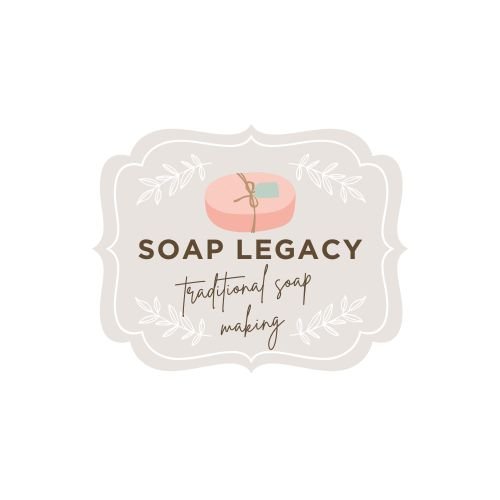
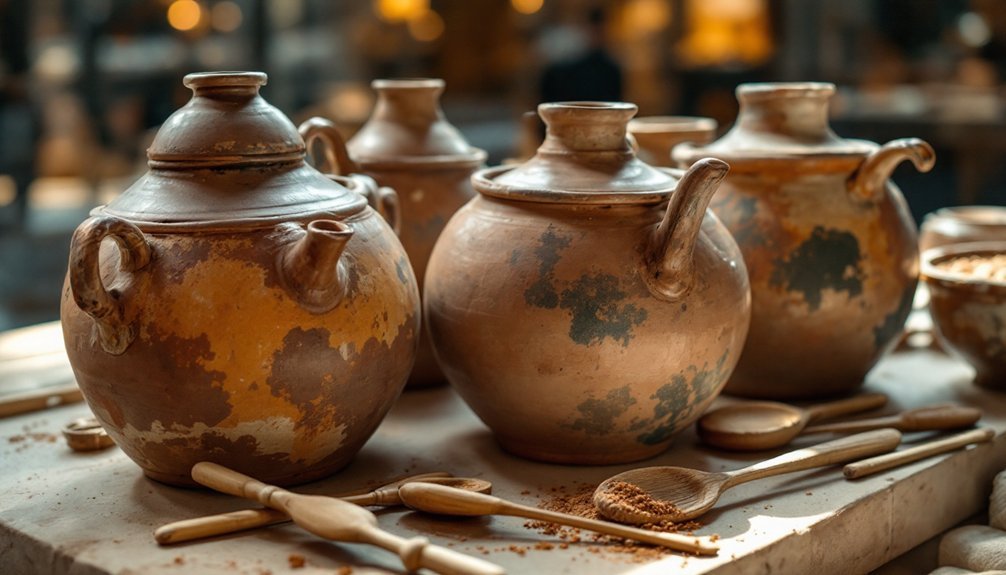


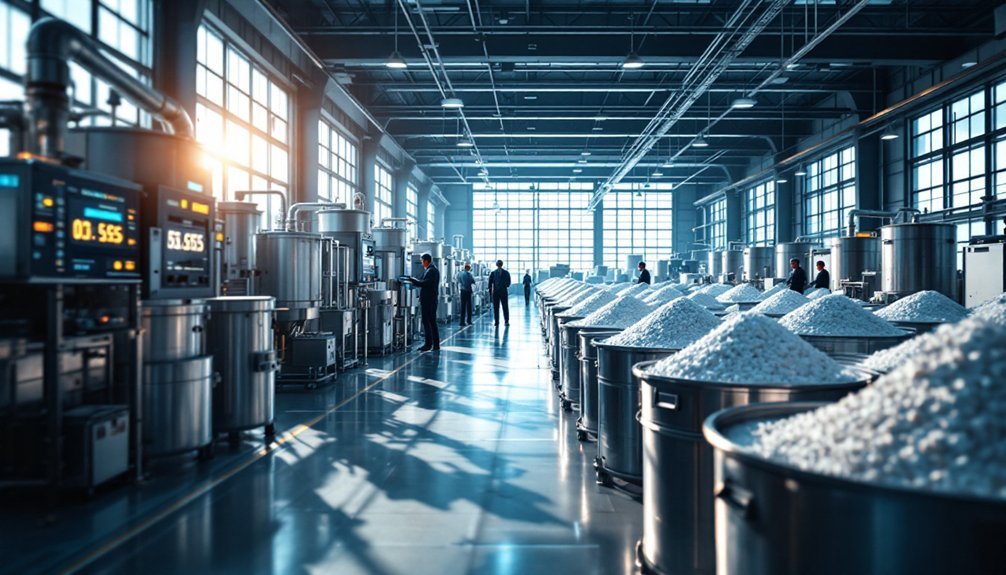
Leave a Reply